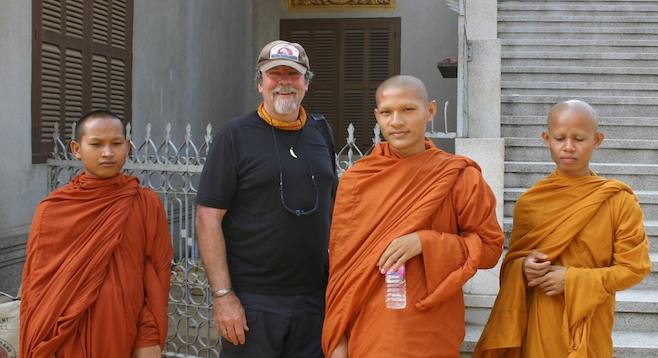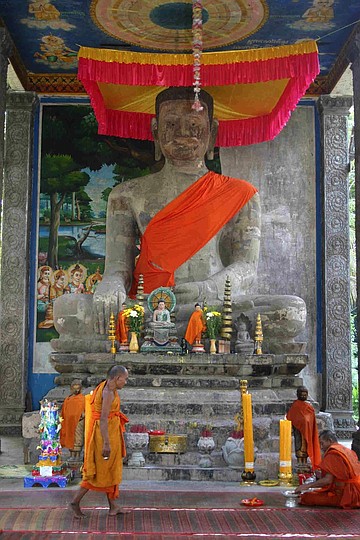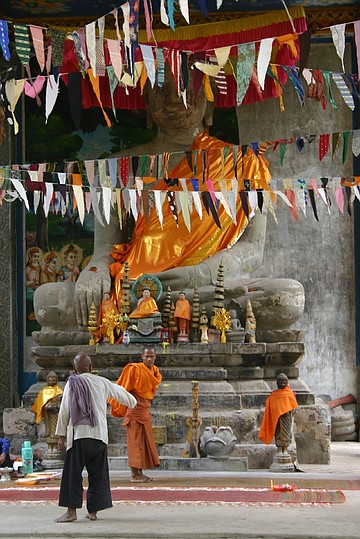 Facebook
Facebook
 X
X
 Instagram
Instagram
 TikTok
TikTok
 Youtube
Youtube

The temples of Cambodia arguably stand alone as the finest blending of art and architecture in the world.
Most people are aware of the monumental achievements in building championed by the Greeks, Egyptians and Mayans. But because of its violent past and geographical isolation, Cambodia has traditionally taken a back seat to those challengers in this arena.
The early Khmers carved stone like most people breathe, and the immense temple complex at Angkor is the apex of the historical documentation and artistic achievement of Khmer architecture. Stone carving is the most physically demanding of all art forms, and the intricate, nuanced beauty of Cambodia’s temples has no rivals. Considering that most of this gigantic project was completed thousands of years ago without the aid of modern machinery – or even metal tools – it defies the imagination.
Not only are these temples beautifully and intricately carved, they incorporate the complete history of the nation in a massive stone bas relief that dwarves any similar such efforts by other civilizations.

While millions of visitors to the country flock to the famous temple sites, few venture into the local jungles to see the countless smaller temples that are the soul of this deeply religious country. It is there that the visitor learns the artistic vision of these people was not limited to massive monuments, but carried over into private, remote shrines that for the most part remain hidden and protected by what's sometimes an impenetrable jungle. Those who find these places discover the master craftsmanship of the ancestors is alive and well, passed down to the hands of generations who still breathe life into the stone.
The Buddha watches over Cambodia, and in the most remote jungles it is common to find beautiful carved shrines filled with minute details in his honor, tended by monks and nuns who have forsaken the material world for a life of contemplation and sacrifice.
In Cambodia most every young man spends two years as a novice monk before deciding to either stay in the religious order or return to the secular world. It's common for women who lose their husbands to become nuns, and the majority of both sexes are jungle dwellers who may spend their entire life tending to one of these remote religious sites. This is a look into the Khmer soul in its purest form.

Imagine cutting your way through jungle so thick as to require a machete and suddenly being confronted by a 20-foot-tall meditating Buddha surrounded by a riot of colorful prayer flags and painted religious scenes from the life of the enlightened one (left). This is exactly what the intrepid jungle traveler can expect to experience off Cambodia’s beaten path.
To be confronted by such a sight in the thickest wilderness is akin to suddenly finding oneself in the midst of an Indiana Jones movie – and often the surreal reaction cause by these shrines does seem like you have wandered onto a movie set.
The only other country that can rival Cambodia for sheer numbers of religious sites is India, and most of those are constructed in populated areas accessible by roads. In Cambodia, the finest examples of such shrines are found in the most remote wildernesses and are often times surrounded by fields saturated with land mines. Yet there is always a faithful cadre of religious and lay persons tending to the site, keeping it swept clean daily, changing old flowers for fresh and even replacing offerings of food on a daily basis.
The logistics of building and maintaining such sites in the deep jungle is staggering, and when you consider that this country has only known peace for the past 25 years it is all the more remarkable. Most of these jungle shrines show the remnants of war: statues pockmarked with bullet holes and shell hits, attending monks and nuns missing limbs. To find one remote site, I passed several leering skulls along the trail warning me not to stray either way because all around was an active minefield.
These shrines are the physical manifestation of the faith of a nation – a nation unbroken after 2,000 years of invasion and war. They are at once a window into the soul of a country, a historical record of its past, and a statement to the world about a culture that refuses to be cowed by adversity.


The temples of Cambodia arguably stand alone as the finest blending of art and architecture in the world.
Most people are aware of the monumental achievements in building championed by the Greeks, Egyptians and Mayans. But because of its violent past and geographical isolation, Cambodia has traditionally taken a back seat to those challengers in this arena.
The early Khmers carved stone like most people breathe, and the immense temple complex at Angkor is the apex of the historical documentation and artistic achievement of Khmer architecture. Stone carving is the most physically demanding of all art forms, and the intricate, nuanced beauty of Cambodia’s temples has no rivals. Considering that most of this gigantic project was completed thousands of years ago without the aid of modern machinery – or even metal tools – it defies the imagination.
Not only are these temples beautifully and intricately carved, they incorporate the complete history of the nation in a massive stone bas relief that dwarves any similar such efforts by other civilizations.

While millions of visitors to the country flock to the famous temple sites, few venture into the local jungles to see the countless smaller temples that are the soul of this deeply religious country. It is there that the visitor learns the artistic vision of these people was not limited to massive monuments, but carried over into private, remote shrines that for the most part remain hidden and protected by what's sometimes an impenetrable jungle. Those who find these places discover the master craftsmanship of the ancestors is alive and well, passed down to the hands of generations who still breathe life into the stone.
The Buddha watches over Cambodia, and in the most remote jungles it is common to find beautiful carved shrines filled with minute details in his honor, tended by monks and nuns who have forsaken the material world for a life of contemplation and sacrifice.
In Cambodia most every young man spends two years as a novice monk before deciding to either stay in the religious order or return to the secular world. It's common for women who lose their husbands to become nuns, and the majority of both sexes are jungle dwellers who may spend their entire life tending to one of these remote religious sites. This is a look into the Khmer soul in its purest form.

Imagine cutting your way through jungle so thick as to require a machete and suddenly being confronted by a 20-foot-tall meditating Buddha surrounded by a riot of colorful prayer flags and painted religious scenes from the life of the enlightened one (left). This is exactly what the intrepid jungle traveler can expect to experience off Cambodia’s beaten path.
To be confronted by such a sight in the thickest wilderness is akin to suddenly finding oneself in the midst of an Indiana Jones movie – and often the surreal reaction cause by these shrines does seem like you have wandered onto a movie set.
The only other country that can rival Cambodia for sheer numbers of religious sites is India, and most of those are constructed in populated areas accessible by roads. In Cambodia, the finest examples of such shrines are found in the most remote wildernesses and are often times surrounded by fields saturated with land mines. Yet there is always a faithful cadre of religious and lay persons tending to the site, keeping it swept clean daily, changing old flowers for fresh and even replacing offerings of food on a daily basis.
The logistics of building and maintaining such sites in the deep jungle is staggering, and when you consider that this country has only known peace for the past 25 years it is all the more remarkable. Most of these jungle shrines show the remnants of war: statues pockmarked with bullet holes and shell hits, attending monks and nuns missing limbs. To find one remote site, I passed several leering skulls along the trail warning me not to stray either way because all around was an active minefield.
These shrines are the physical manifestation of the faith of a nation – a nation unbroken after 2,000 years of invasion and war. They are at once a window into the soul of a country, a historical record of its past, and a statement to the world about a culture that refuses to be cowed by adversity.
Comments